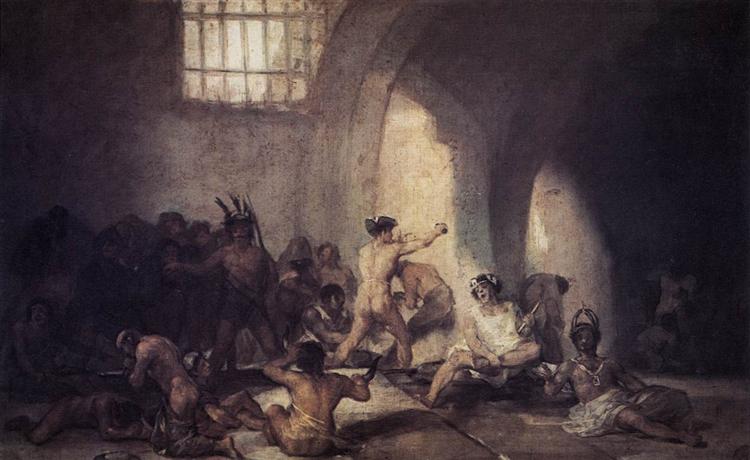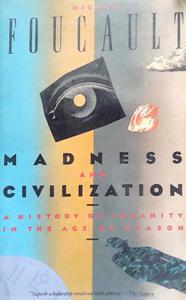Michel Foucault
Richard Howard (translation from French)
New York
1965 (Vintage Books Edition, 1988)
299 pages
According to the art:
Michel Foucault digs into the history of madness from the sixteenth century to the nineteenth century Western Europe and the U.S. This period corresponds roughly from the time when “madmen were allowed to wander in the open countryside,” through a period of exclusionary practices, and until the “birth of the asylum.”
Synopsis:
Michel Foucault, known for his “archeological” investigations in subjects that interest him, digs into the history of madness for this book. He limits his investigation to the period from the sixteenth century to the nineteenth century, and to western Europe and the U.S. This period corresponds roughly from the time when “madmen were allowed to wander in the open countryside,” (p. 8) through a period of exclusionary practices, and until the “birth of the asylum.” The course of these transitions reflected how madness was understood across that time.
Foucault enters his subject when madness—“unreason”—existed within the range of ordinary human characteristics, although acceptance of madness was not uniform or consistent from his telling. Frequently madmen “were handed over to boatmen…[who] were instructed to rid the city of a madman who walked about the streets naked,” or taken to “a place of detention reserved for the insane.” (p. 8)
Eventually, Foucault notes, Western civilization starts conceptualizing madness as a state of being in its own way rather than just a point on the continuum of human behaviors. He endeavors to find when this happened.
We must try to return, in history, to that zero point in the course of madness at which madness is an undifferentiated experience, a not yet divided experience of division itself. We must describe, from the start of its trajectory, that ‘other form’ which relegates Reason from Madness to one side of the other of its action as things henceforth external.
p. ix
The continuum of reason and unreason was cracking and differentiating the man of reason from the man of madness was coming into view. However, nothing at the time validated where the crack between reason and unreason formed other than how they related to one another, i.e., unreason was what reason wasn’t. The language available then to better demarcate the distinction didn’t help, and in Foucault’s analysis, was “incipient and very crude.” (p. x)
With the distinction between reason and unreason then appreciated, however blurry, Foucault describes how “the Madman, the Fool, [and] the Simpleton” drew the interest of theater, literature, painting, music, other art forms, and academic domains. Through these filters, madness was further delineated and partitioned, and “no longer considered in its tragic reality, in the absolute laceration that gives it access to the other world; but only in the irony of its illusions.” (p. 32) These ironic illusions of madness “haunted the imagination of Western man” with claims “that it is closer to happiness and truth than reason, that it is closer to reason than reason itself.” (pp. 14-15)

Francisco Goya 1812-1814
In the middle of the seventeenth century, a time Foucault marks as when “madness began to rank among the problems of the city,” (p. 64) and consequently, as the beginning of “The Great Confinement.” The mad were gathered and put into various institutions in great haste, and would for the next century and a half. Foucault reports that at the Hôpital Général in Paris, the mad were not confined amongst themselves, but rather with the poor, the unemployed, and the criminals. To be sure, he goes further to say, this institution “had nothing to do with any medical concept…[and] it was directly linked with the royal power which placed it under the authority of the civil government alone.” (pp. 40-41) What started in France would spread quickly throughout Europe.
Foucault traces origins of confinement to the lazar houses built first in the early thirteenth century as places for isolating lepers. There the lepers were kept until they all but disappeared four hundred years later. He points to these preexisting structures as enabling The Great Confinement. “Ultimately, confinement did seek to suppress madness, to eliminate from the social order a figure which did not find its place within it.” (p. 115) The “village idiot” was no longer tolerated, nor was the family member “who by vile and abject habits shames his relatives.” (p. 67)
Across several chapters covering the time of The Great Confinement, Foucault reports how the mad were treated and how ideas about madness evolved. Madness was scandal, animality, and unreason, and arose from passions and delirium. Further along inquiries began into the nature of causes for “mania and melancholia,” and for “hysteria and hypochondria.” Over time these inquiries pointed towards pathophysiological problems in the brain and nervous system, as for example when, according to Foucault, a neuroscientist attributed melancholia to “a drier and firmer tissue of the brain’s medullary substance.” (p. 135) Ideas and actions concerning treatment and cures followed, many of which Foucault discusses.
A gaining appreciation for madness as a distinct problem—“the mad are only mad”—did not result in a similar appreciation that the mad should be separated from criminals and libertines. (p. 223) To the frustration of leading voices at the time, as Foucault recounts, “there was indignation that the mad were not treated any better than those condemned by common law or than State prisoners.” (p. 221) Ironically, it would be the criminals and the libertines who “were the first to protest, and with the most violence,” towards getting away from their mad cellmates. (p. 224) Towards the end of the eighteenth century, confinement was limited to those who were “mad,” which freed those who were confined because of “moral transgressions, family conflicts, and the most benign aspects of libertinage.” (p. 235). This progress led further to the establishment of asylums. Foucault points to the work of the Quaker philanthropist Samuel Tuke and the French physician Phillipe Pinel as pivotal to the structures and functions of asylums, which included the application of medical knowledge, i.e., psychiatry. He leaves it there, where the mad were given asylum.
Analysis:
Where Foucault ends at the beginning of the nineteenth century is not the end of history for madness. Starting in the early twentieth century and accelerating through its second half, asylums fell out of favor. By the end of the century, many of the asylums had been emptied and were repurposed, taken down, or left as hulking relics. Many factors drove the demise of asylums, including reductions in state financial support, reports about abusive treatment of residents, infringements of residents’ rights to choose where they live, and pharmacological advancements and outpatient clinics expected to make long-term housing in asylums much less necessary. Alas, “sidewalk psychotics” have returned and again “rank among the problems of the city” as they did four hundred years ago.
Foucault’s account of madness from the sixteenth to the nineteenth century, combined with how madness has been perceived and addressed since shows its history as scaffolding in nature rather than linear. That is, while perceptions and practices advance over time, they also regress to earlier rejected forms and then advance again. In the current moment, while the mentally ill in many cases are left to their own devices as they were centuries ago, efforts are being made to understand the neuroscience and genetics that may be at work in the causes of mental illness and that may be the key to effective treatments. Alas, those who could benefit from them will have to wait longer as none of these efforts have borne fruit yet.
Cities and states are desperate again. Their responses may involve reverting to some previously abandoned approaches. If the Foucaultian scaffolding is at work, then embarkation and confinement could be in the future for the present-day madman.
Also:
The scaffolding form of progress characteristic of mental illness is seen in other diseases such as heart disease for example.



